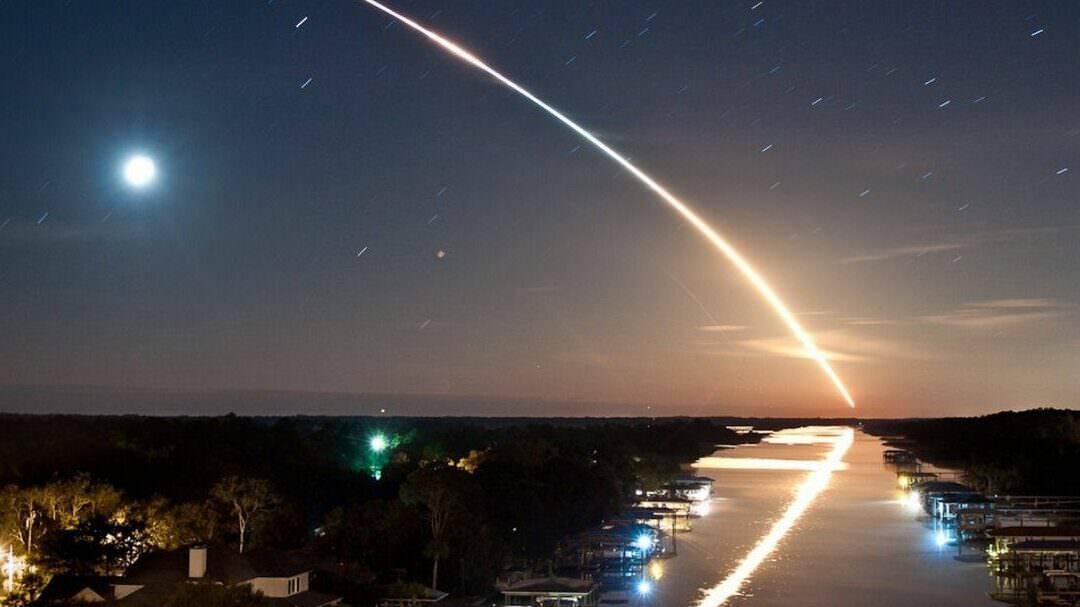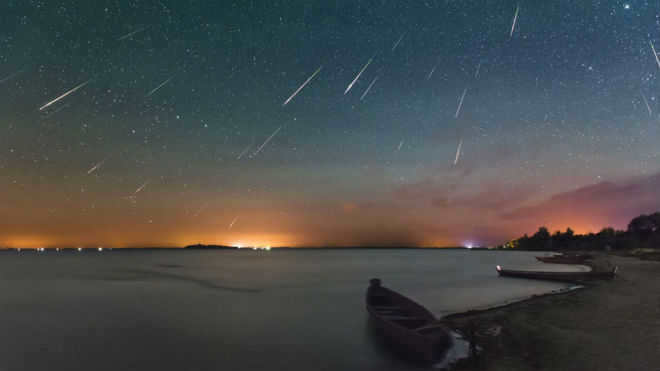
The phenomenon known as a meteor shower is considered to be one of the most captivating and fascinating cosmic events. Numerous stargazers tend to mistake these shooting stars for actual stars when they spot them in the night sky. It’s a sight that never fails to astonish adults and even inspire children to make a wish. However, contrary to popular belief, meteor showers are not related to stars but rather have their origin tied to comets.
What is a meteor shower
A meteor shower is a phenomenon where small pieces of asteroids or comets, known as meteors, enter the Earth’s atmosphere at incredibly high speeds (up to 80 km/sec) and burn up, creating a bright streak of light in the sky. Essentially, meteors are fragments of space debris.
As meteors pass through the Earth’s atmosphere, they ignite due to the intense heat generated by the friction between the surface of these celestial bodies and atmospheric gases. Once ignited, meteors become visible to observers on Earth, appearing as dazzling bursts of light.

The duration of meteors burning is brief. Generally, as they are small in size, they completely incinerate in the atmosphere before reaching the surface of the planet. However, larger objects may not fully burn and break apart in the atmospheric layer, falling to the ground and being referred to as meteorites.
The occurrence of individual meteors and meteor showers can happen at any time throughout the year. However, specific showers of cometary debris happen annually during a particular period and have been observed by humans for centuries and millennia:
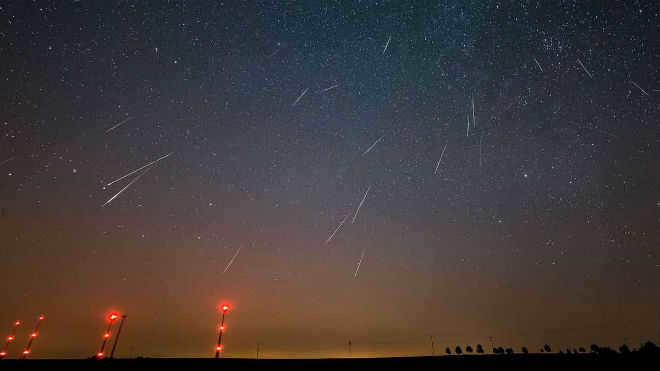
- The Aquarids (April 25-May 20) are meteors that come from Halley’s Comet. On average, there are 35 objects that fall per hour.
- The Draconids (mid-October) come from the Giacobini-Zinner comet. The radiant can be found in the “head” region of the Dragon constellation.
- The Lyrids (late April) originate from the Thatcher comet. The radiant is located between the Lyra and Hercules constellations. These meteors have been observed for 2500 years.
- The Quadrantids (early January) have an unspecified origin. The radiant can be found in Volopassus, closer to the Hercules and Dragon constellations. The name of this annual meteor shower, Quadrantids, is related to the now extinct Wall Quadrant constellation, which was once located in this part of the sky.
- Geminids (mid-December) occur when the radiant is near Castor, which is the beta star of Gemini. The flux orbit of this meteor shower has a unique perihelion radius, which is the closest point to the Sun, of only 0.14 a.u.
- The Orionids (October 15 – 28) originate from Halley’s Comet and their radiant is in Gemini, closer to Orion.
- Leonids (mid-November) come from comet Tempel-Tuttle and can be observed coming from the “head” part of the Leo constellation.
- The Perseids meteor shower (July 25-August 20) is the most intense and beautiful one, and it is associated with the Swift-Tuttle comet. The radiant is located near the eta star Perseus. During its peak, the density of meteors can reach up to 100 objects per hour.
- Taurids (September 15-November 30) have a double radiant and are located in the Taurus constellation.
What is the origin point of a meteor shower
As the celestial objects travel towards the Earth’s surface in a nearly parallel manner, it gives the impression to an observer on Earth that the shower of stars is originating from a specific location in the sky. This particular celestial spot is referred to as the radiant.

Typically, meteor showers receive their names from either a constellation or a specific star located in the region of their origin. For instance, the radiant point of the Leonid meteor shower is found in the Leo constellation, while the Draconid meteor shower originates from Draco.
The Formation of Meteor Streams
Meteor streams are formed as a result of collapsing comets as they approach the Sun, which leaves behind solid particles known as cosmic dust. When the orbits of the Earth and the comet intersect, observers from the surface of our planet witness the phenomenon of “shooting stars,” as they witness the cosmic dust orbiting the comet’s tail.
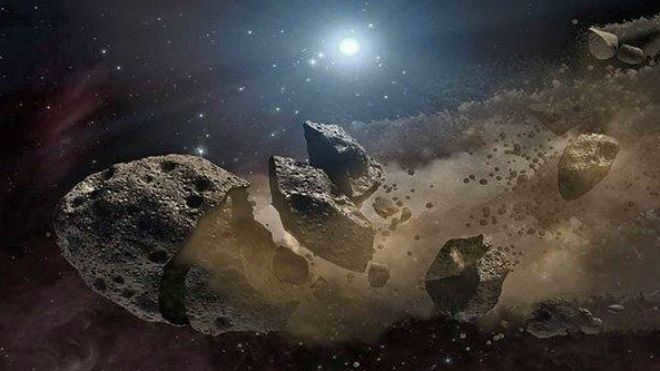
In order to comprehend the occurrence of meteor showers, one must envision the unique characteristics of comets’ material composition and orbits. The orbit of a comet is highly elongated: when it reaches perihelion, it is heavily exposed to the Sun’s radiation, while at aphelion (the furthest point from the Sun), the level of radiation is minimal. As the comet, composed of ice, rock, and dust, approaches the Sun, its structure begins to disintegrate. Dust particles and fragments of rock are expelled into the tail, forming a plume in orbit.
When the Earth, in its own movement, collides with this plume, meteor showers are observed from its surface. These showers can vary in intensity, as the rate of destruction of cometary matter differs at different stages of approaching the Sun.
History of Observation
In the past, people were able to observe meteor showers with just their eyes. However, with the advancements in modern equipment, astronomers now have the ability to observe cosmic streams in great detail. This has led to a vast accumulation of astronomical data. By visually studying the streams in the sky, scientists from previous centuries were able to establish a correlation between meteors and comets, as well as determine the orbits of many comet trails.
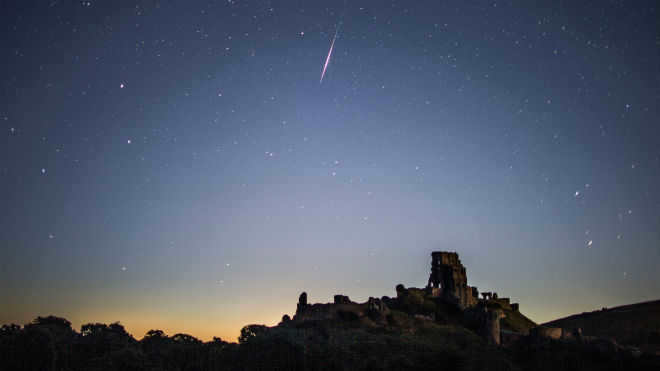
The credit for the discovery of the connection between comets and meteors goes to the renowned Italian astronomer Giovanni Schiaparelli. Back in August 1866, while observing the Perseids, Schiaparelli astutely observed that the orbit of meteor particles was remarkably close to the orbit of the recently discovered Swift-Tuttle comet.
This connection between comets and meteors was further validated by the great Isaac Newton and the English scientist Adams. Newton meticulously studied reports of an intense “star shower” originating from the Leo constellation, which was observed in both 1799 and 1833. Based on his research, Newton proposed that this phenomenon occurred every 33 years and predicted a recurrence in 1866. His prediction was indeed confirmed in November 1866. Adams, on the other hand, determined the orbit of the Leonidas meteor shower and discovered its striking similarity to the orbit of the Tempel-Tuttle comet.
Witnessing a magnificent spectacle in the skies is a task that everyone can easily accomplish. There is no requirement for telescopes in order to catch a glimpse of the grand celestial rivers. The key factors are a night without the presence of the moon and the absence of any other sources of light in close proximity. The ideal time for observation is during the summer season, when the heavens are adorned with both subtle and powerful streams, including the captivating annual Perseids.

Meteors (derived from the Greek word μετέωρος meaning celestial) are luminous phenomena that occur in the Earth’s atmosphere due to the entry of solid meteoric bodies (meteoroids). As these meteoric bodies interact with the atmosphere, they lose mass and create what is known as a meteor trail – a trail of ionized gas and dust that follows the path of the meteoroid. Meteors appear as star-like objects that suddenly appear, move rapidly, and then fade away, which is why they have been commonly referred to as shooting stars. Bright meteors can be even more luminous than the brightest planets, and are known as bolides. When a group of meteor bodies that are moving in the same orbit enters the Earth’s atmosphere, a meteor shower is observed.
Historical context
Humanity has been aware of meteors since ancient times, as evidenced by the legends and myths of various cultures. The earliest written accounts of meteors can be traced back to an Egyptian papyrus dating back to 2,000 years B.C. Furthermore, ancient Chinese manuscripts from 1768 B.C. consistently mention observations of meteors. In the Old Russian chronicles, the earliest recorded instances of meteors date back to 1091, 1110, 1144, and 1215.
In the year 1798, there was a groundbreaking discovery made. It was the first time that the heights of 22 meteors were accurately determined through simultaneous observations from two points that were 14 kilometers apart. Fast forward to the meteor shower of 1832-1833, and many keen observers noticed something interesting. They observed that the visible paths of the meteors seemed to originate from a specific point in the celestial sphere, which is now referred to as the radiant of the meteor shower.
This led to a fascinating conclusion – all the meteor bodies in the stream that caused the meteor shower were moving in parallel trajectories. Essentially, these bodies were moving in close orbits in outer space. This discovery was a significant development in the 19th century.
As time went on, scientists were able to establish a connection between meteor streams and comets. They even calculated the orbits of various meteor streams and created catalogs that documented a large number of radiant meteor streams.
The first photograph of meteors was received by L. Weyneck in 1885. In 1893, American astronomer H. Elkin utilized a rotating shutter (obturator) to calculate the angular velocity of meteors during photographic observations. S. N. Blazhko obtained the initial photographs of meteor spectra in 1904. The practice of photographing meteors became widespread in the 1930s and 1940s. By conducting baseline observations with 2-3 cameras equipped with skirts and directed towards a specific region of the celestial sphere, researchers were able to determine the trajectories and velocities of meteor bodies in space, and therefore, their orbits.
Between 1929 and 1931, researchers discovered the effect of meteor ionization on radio wave propagation. Subsequently, in 1942-1944, the first radar observations of meteors were conducted.
Meteor astronomy focuses on exploring the origins, development, and distribution of meteor bodies in the vast expanse of interplanetary space.
The formation of meteor bodies can occur through various mechanisms. As a comet approaches the Sun, the ice within its nucleus undergoes sublimation, resulting in the release of solid particles. These particles then continue to orbit alongside the comet’s nucleus, creating a meteor swarm. Additionally, meteoroids can be generated when asteroids collide with one another, or when particles are dislodged from the surfaces of celestial bodies with weak atmospheres, such as Mercury, Mars, or planetary satellites. The mass of these dislodged fragments is typically around 10 3 times greater than that of the original meteoroid.
The typical lifespan of a meteoroid is approximately 10^5 years. Particles weighing less than 10^-16 kg are expelled from the Solar System due to the pressure exerted by solar radiation, which exceeds the gravitational force of the Sun. Objects with greater mass experience deceleration as a result of the Poynting-Robertson effect, causing the meteoroid to follow an elliptical spiral towards the Sun, where it eventually vaporizes.
Our understanding of the distribution of meteoric bodies in interplanetary space is limited. This is because ground-based instruments can only detect meteoroids that intersect with Earth’s orbit, which represents a small fraction of the overall meteoroid population. Spacecraft are capable of detecting meteoroids outside of Earth’s orbit, but their observations are primarily limited to the ecliptic plane, where spacecraft orbits are typically situated.
Methods of Meteor Observation
There are various techniques utilized for observing meteors, including both visual and instrumental methods such as photography, optics, and radar. Visual observations have taken a back seat with the advancement of instrumental meteor research methods. However, in recent years, astronomers have been able to enhance the accuracy of visual observations to match that of instrumental methods through specialized processing techniques. This breakthrough has allowed researchers to analyze historical data, including the systematic observations of F. A. A. Bredikhin, and track the evolution of meteor showers such as the Perseids and Leonids over a span of 120 years.
Telescopes are utilized in optical observation techniques to amplify the sensitivity and improve the resolution of the equipment. Present-day optical methods employ CCDs as light receptors, enabling the recording of dimmer meteors. While photographic observations typically had a minimum recorded stellar magnitude of +3, contemporary optical methods require a minimum stellar magnitude of +4 to +5.
Radio observations of meteors can be conducted using the reflection of radio waves from ionized meteor trails. This method is different from visual and optical observations because it allows for continuous monitoring, which is essential for studying meteoroids that intersect the Earth’s orbit. There are two types of radio observations of meteors: radar and foreshortening (forward scattering). Radar observations involve using a transmitter and receiver antenna at the same location, and sometimes even sharing a common antenna. Pulsed radio signals are sent to a specific area of the sky, reflected off meteor trails, and received by the antenna. The signal then goes to a recording device where various parameters are measured, including the distance to the meteor trail, the amplitude of the signal over time, the duration of the signal, the velocity of the meteoroid, the angle of arrival of the signal, and for baseline observations, the velocity vector of the meteoroid. In foreshortening observations, the transmitter and receiver are located more than 80-100 km apart, beyond line of sight. In this case, the receiver does not directly receive radiation from the transmitter (because radio waves have limited range), but it can detect signals that are reflected off meteor trails.
Physical explanation of meteors
The physical explanation of meteors involves understanding the various physical phenomena that occur when a meteor enters the Earth’s atmosphere. These phenomena include the glowing and ionization of the atmosphere, as well as the reflection of radio waves from the trail left by the meteor.
Meteoroids that orbit the Sun in elliptical paths enter Earth’s atmosphere with velocities ranging from 11 to 72 km/sec. The way they interact with the atmosphere depends on the mass and density of the meteoroid. When the size of the meteoroid is much smaller than the average distance between the molecules in the upper atmosphere, the interaction occurs through individual molecule impacts on the meteoroid’s surface. During these collisions, the molecules transfer their momentum and kinetic energy to the meteoroid, causing it to slow down, heat up, and break apart. The intense vaporization, or sublimation, of the meteoroid starts when its surface temperature reaches around 2000 °C. The meteoroid can also lose material through a process called ablation, where smaller particles or droplets separate from the main body. Meteoroids with masses less than 10-12 kg slow down and heat up to the temperature required for intense vaporization at altitudes between 110 and 130 km. However, due to atomization, these particles settle on Earth’s surface as micrometeorites. On the other hand, meteoroids with masses greater than 10-12 kg penetrate denser layers of the atmosphere, where heat loss through thermal radiation is less significant. Meteoroids in the mass range of 10-12 – 10-2 kg, which produce meteors ranging from +20 to -4 in brightness, lose most of their mass before they have a chance to slow down in the atmosphere. When larger meteoroids (which produce bright fireballs) travel through the atmosphere, they create shockwaves that reduce heat transfer and, consequently, mass loss. The remnants of these meteoroids can fall to the Earth’s surface as meteorites.
The height of meteors is determined by the initial velocity and density of the meteor bodies. Meteor bodies can be classified into two groups based on their average density ρ ρ ρ ρ: dense [ ρ = ( 1 – 5 ) × 1 0 3 kg / m 3 ] and friable [ ρ = ( 0.2 – 1 ) × 1 0 3 kg / m 3 ] . The ablation maxima of Group 1 meteoroids, which correspond to the maximum brightness and trace ionization of the meteor, are higher when the velocity, initial mass, and density of the meteoroid are lower. Group 2 meteoroids with masses less than 10 -4 kg break up into smaller particles of similar mass during heating. These particles are then vaporized at the same height in the Earth’s atmosphere during the ablation process, regardless of the initial mass of the meteoroid. Larger meteoroids do not fully disintegrate and the height of the luminosity and ionization maximum decreases as the initial mass increases.
When a meteoroid enters the atmosphere, the atoms it loses initially have the same velocity as the meteoroid itself. This velocity is much greater than the average velocity of the surrounding cold air molecules. However, after a series of collisions with these molecules, the velocities of the atoms and molecules equalize within about 10^-3 seconds. During these collisions, the neutral atoms become excited and emit light when they return to their ground state. Additionally, the atoms of the meteoroid become ionized. The result is a luminous and ionized meteor trail, which has free electrons that can reflect radio waves in a coherent manner. When there is a high concentration of electrons, the meteor trail behaves like a metal cylinder in terms of reflecting radio waves. Eventually, the ionized meteor trail is destroyed through diffusion. All meteor trails are found within the altitude range of 80-140 km.
Meteor wireless communication
Meteor radio waves can be picked up by an antenna that is within the direct line of sight of the transmitting antenna. In the 1950s, the concept of utilizing the reflection of radio waves from ionized meteor trails to transmit data in the VHF range for distances up to 2200 km arose. The concept was as follows: at two endpoints of a radio route, the receiving and transmitting antennas are pointed towards a specific area of the sky above the midpoint of the route, and both transmitters continuously emit radio waves (without transmitting any information) into this area. When a meteor appears that meets the conditions for mirror-like reflection of radio waves, the receivers start receiving signals from the distant transmitter. At this point, the system for transmitting useful information is activated. The transmission time is limited by the duration of the ionized meteor trail – ranging from fractions of a second to several seconds. Therefore, only a few percent of the total time can be utilized for transmitting information, and the average transmission rate (per unit of time) amounts to just 10-15 bytes/second. With the introduction of new high-speed radio communications, meteor radio communication has become obsolete and is now only used for synchronizing two spatially separated time standards (with a precision of 1 ns), as well as for specialized communications.
Meteoric Geophysics
The region between 80 and 110 km in altitude, where meteors are observed, presents a challenging environment to explore. The dense air at this height poses difficulties for artificial satellites, causing them to experience strong deceleration and ultimately fall out of orbit. Additionally, rocket probes can only briefly reach these altitudes. As a result, meteors offer a unique opportunity to investigate the characteristics of the atmosphere within this range. For instance, by studying the radio reflections produced by meteor trails, researchers have been able to identify daily and seasonal variations in winds and gain insights into the turbulent dynamics of the atmosphere.
Meteor dangers
Meteoroids present a potential threat to spacecraft, as they have the ability to cause damage to external equipment, puncture the hull of an orbital station or a manned spacecraft, and even penetrate the spacesuit of an astronaut on a spacewalk. Even small meteoroids with a mass of 10 -5 -10 -7 kg can cause significant damage due to their high velocity. As a result, all nations engaged in space exploration take into account the risk of meteoroid impacts when designing and testing spacecraft to ensure their reliability in such conditions.
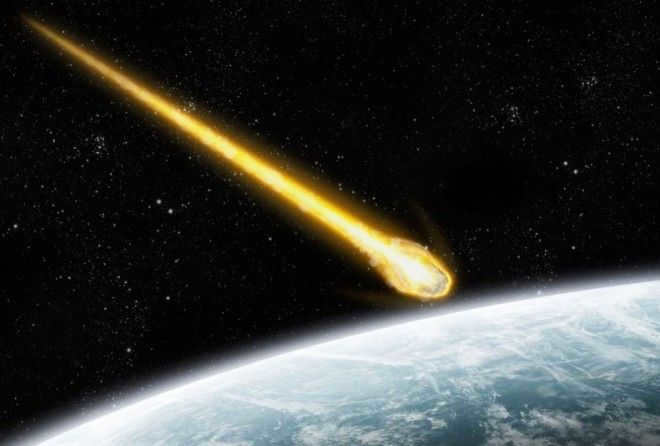
Comet
A comet is a small celestial body that orbits the Sun and is composed of solid particles in its nucleus. When a comet gets closer to the Sun, it develops a coma, which is a cloud of dust and gas, and sometimes a tail. Only a very small percentage of comets are visible to the naked eye, as they need to come close enough to the Sun and Earth. Comets that come from deep space appear as hazy objects and often have a tail that can stretch for millions of kilometers.
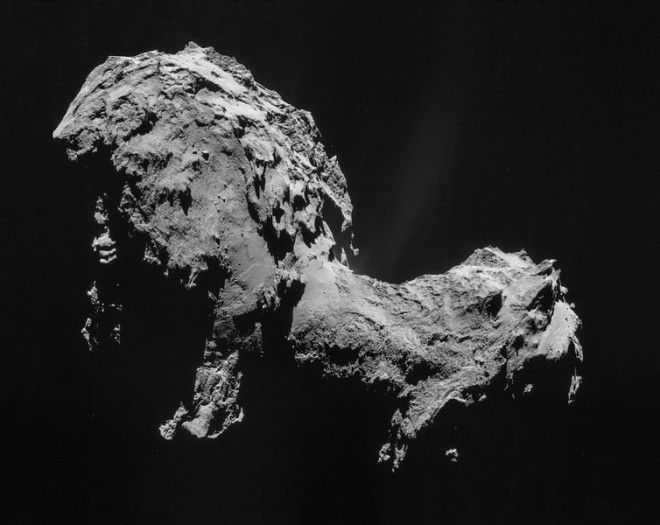
The Rosetta probe captured an image of Comet 67P/Churyumov-Gerasimenko
Definition of an Asteroid
An asteroid is a celestial body that has a diameter of more than 30 meters (smaller bodies are known as meteoroids). These irregularly shaped objects do not have an atmosphere, although they may have moons. Prior to 2006, the term “asteroid” was used interchangeably with “small planet.”
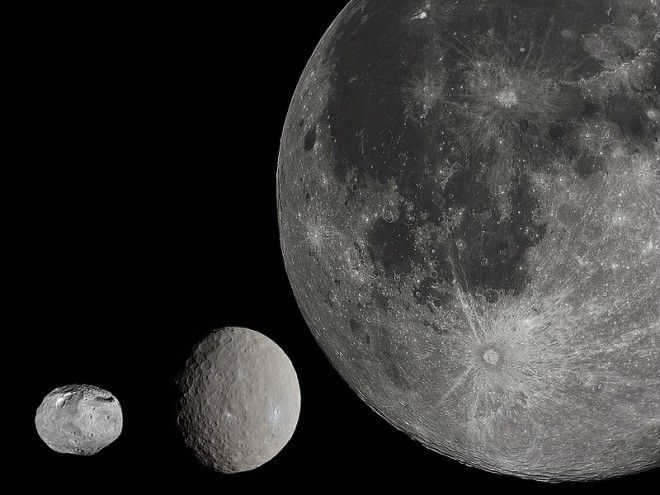
The sizes of the asteroid Vesta, the dwarf planet Ceres (in the center), and the Moon (on the right) are compared.
Meteoroid
A meteoroid is a celestial body that is bigger than space dust but smaller than an asteroid. When a meteoroid enters the Earth’s atmosphere at high speed, it gets heated up due to friction and burns up, creating a glowing meteor.
Meteoroid, meteor, and meteorite
Meteor
Meteor, also known as a “shooting star”, is a phenomenon that should be differentiated from meteorites and meteoroids. A meteor is not an actual object (which is a meteoroid), but rather a luminous trail left by a meteoroid. The trail of a meteor typically vanishes within seconds, although in rare cases it can persist for minutes.
Space Rock
A space rock is a tangible object from outer space that has landed on Earth. The biggest space rock ever discovered is situated in Namibia. The Goba space rock, with a weight of approximately 66 tons, descended around 80,000 years ago and was unearthed in 1920. It is primarily composed of iron.
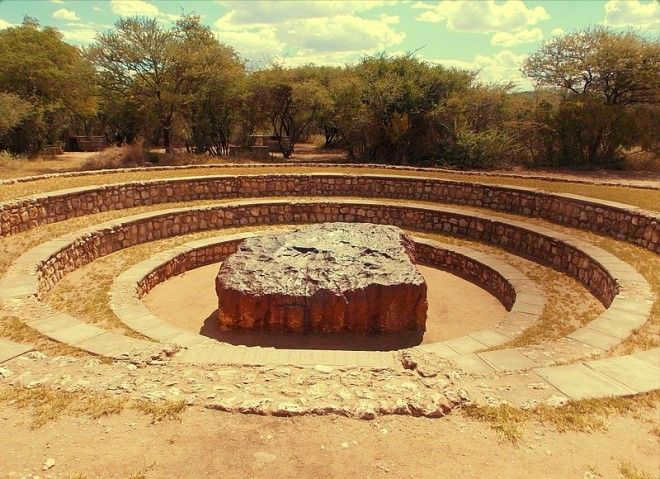
Spread the word about this article to your buddies
There exist multiple events in which metallic rocks are created. As a comet gets closer to the Sun, solid particles are expelled from its core. They follow the same path as the comet itself. When these fragments crash into a planet with an atmosphere, they give rise to a cluster of meteoric rocks.
What is a meteor; a meteorite?
From the time I was a child, I have always had a fascination with gazing up at the night sky and admiring the stars. I would often find myself laying on the ground, captivated by the beauty of shooting stars streaking across the darkness. This deep appreciation for the celestial world made the study of astronomy a natural fit for me during my school years. I eagerly anticipated each new lesson, eagerly soaking up knowledge and eagerly awaiting new discoveries. It was during one such lesson that my class was taken on a field trip to a planetarium, where we were introduced to the wonders of constellations, meteors, and asteroids. Today, I would like to share with you my understanding of meteors and delve into the fascinating nature of these celestial phenomena.
Many people often ask: what exactly is a meteorite and how does it differ from a meteor? The truth is, these two are almost indistinguishable from each other, except for a few key characteristics. Meteors are essentially any foreign objects in the atmosphere that burst into flames. In simpler terms, they are bodies that burn up in the atmosphere before reaching the surface of the Earth. Now, let’s talk about the difference between meteors and meteorites.
Meteorites are often formed from fragments of asteroids or meteors, which is why we can witness meteor showers every year in early summer.
What is a meteorite
A meteorite is a large luminous object that does not completely burn up in the Earth’s atmosphere and instead falls to the surface due to gravitational forces. Every year, a significant number of meteorites land on our planet, creating sizable craters on the Earth’s surface. One of the most well-known craters is the Arizona Crater, an enormous hole that measures 1500 orders of magnitude in diameter. However, there are even larger craters, such as the Wilkes crater on Earth, which spans over 500 kilometers in diameter.
Have you ever had a dream about a hopper? Once, during a night sky observation, I witnessed a magnificent sight – a trail of passing meteors. I made a wish upon seeing them, but for some unknown reason, it hasn’t come true yet. However, I refuse to lose hope and continue to hold onto my belief in miracles!
Characteristics of Meteors and Meteorites
Meteors are small extraterrestrial objects that enter the Earth’s atmosphere and are rapidly disintegrated due to friction. These objects do not reach the Earth’s surface, so astronomers can only identify them as brief, bright streaks in the night sky. They are also known as shooting stars. The Earth’s atmosphere encounters several hundred million of these meteors every day.
In contrast, meteorites are labeled rocks that successfully make their way to the Earth. We receive hundreds of such meteors on a daily basis. Upon impact with the Earth’s surface, they maintain their significant weight.
Meteors are most effectively examined through the study of meteors. Scientists categorize them based on their composition:.
The Perseid meteor stream, also known as the Perseid meteor shower, is of special interest. This yearly meteor stream takes place from August 12 to 14, between midnight and dawn. It is believed to have originated from a comet, as evidenced by the presence of a meteorite.
Meteor streams
Scientists approximate that Earth is bombarded with 44 tons of meteorites on a daily basis. Every night, several meteors are usually observed per hour. Occasionally, the number of meteors significantly increases, resulting in meteor showers. These events can occur annually or at regular intervals when Earth traverses the dusty debris trail left behind by comets.
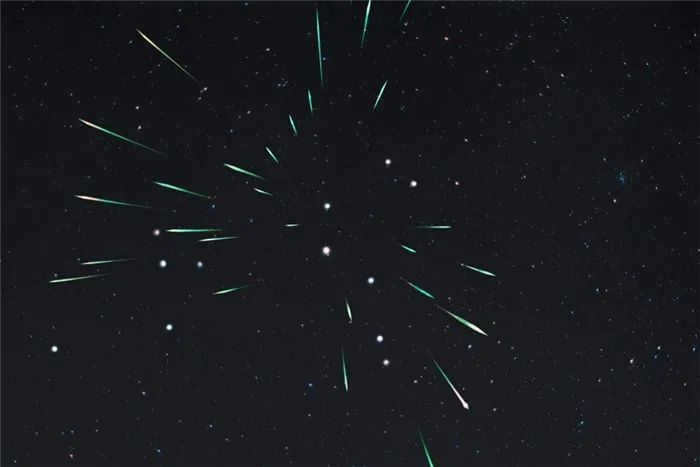
Meteor showers are typically given names based on the star or constellation closest to where the meteor appears in the sky. One of the most well-known examples is the Perseid meteor shower, which occurs annually on August 12th. Each meteor in the Perseid shower is a small piece of debris from the Swift-Tuttle comet, which has a 135-year orbit around the Sun.
Other comets associated with meteor showers include Lioness (Tempel-Tuttle), Aquarius, Halley, and Taurus (Enke). The majority of the dust from these comet streams burns up in the Earth’s atmosphere before reaching the surface. However, some of this dust is collected by aircraft and analyzed in NASA laboratories.
Meteorites are fragments of rocks and metals that survive the journey through the atmosphere and land on Earth. They come from asteroids and other celestial bodies. These meteorites can vary in size, with most being the size of a pebble fist, while others can be larger than buildings. In the past, Earth has experienced numerous meteor strikes that have caused significant damage.
One of the most well-preserved craters is the Barringer meteorite crater in Arizona, which spans about 1 km in diameter. It was formed when a 50-meter diameter fragment of iron-nickel metal fell to Earth. This crater is approximately 50,000 years old and serves as a valuable source for studying the effects of meteorites. Since 1920, when impact craters were officially recognized, about 170 craters have been discovered on Earth.
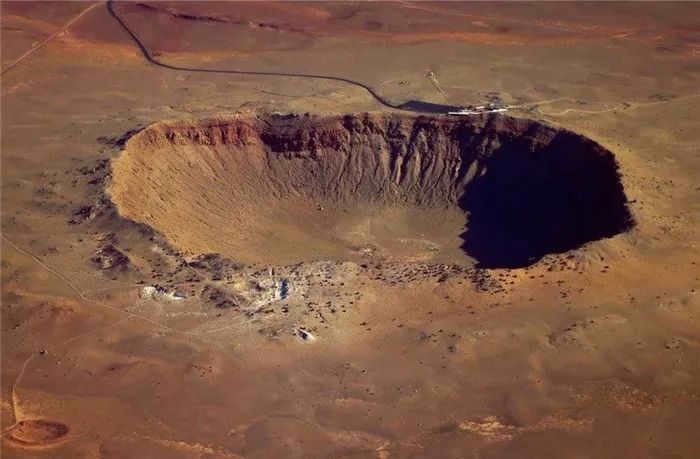
The crater caused by the impact of a powerful asteroid, known as the Ballinger meteorite, is a fascinating phenomenon. It is estimated to have a diameter of about 300 km (180 mi) and is located on the Yucatan Peninsula. This event, which occurred 65 million years ago, had a devastating effect on Earth’s marine and terrestrial fauna, leading to the extinction of approximately 75% of species at that time, including those in the oceans.
In terms of meteorite damage and loss of life, there have been relatively few incidents. However, one notable case occurred in the United States. In November 1954, Ann Hodges of Sylacauga, Alabama, was injured when a stone meteorite weighing 3.6 pounds fell onto the roof of her home.
Meteoroids can resemble terrestrial rocks, but typically have a scorched exterior. This incandescent shell is formed by the meteorite undergoing melting due to friction as it traverses the atmosphere. There are three primary classifications of meteorites: metallic, stony, and stony-metallic. The majority of meteorites that descend onto the Earth’s surface are composed of stone, but the most recently discovered meteorites tend to be metallic. These more massive objects are comparatively easier to differentiate from terrestrial rocks than their stony counterparts.
Sources of meteorites
There have been over 50,000 meteorites discovered on Earth. Out of these, 99.8% originate from the asteroid belt. Proof of their asteroidal origin is determined by calculating the trajectories of meteorite impacts based on photographic observations and projecting them onto the asteroid belt. Examination of various types of meteorites reveals their correlation with specific categories of asteroids, which are also approximately 4.5-4.6 billion years old.
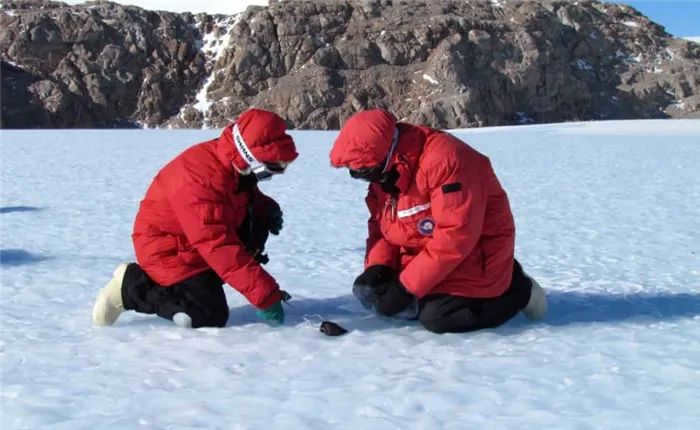

A team of researchers has uncovered a collection of fresh meteorites in the remote wilderness of Antarctica.
However, they only discover those that correspond to a set of meteorites originating from a specific type of asteroid (Eucritica, Diogenes, and Howard). These magmatic meteorites originate from Vesta, the third largest asteroid. The asteroids and meteorites that reach Earth are not remnants of a collapsed planet, but rather consist of the original material from which the planet was formed. The study of meteorites provides insights into the conditions and processes that occurred during the formation and early history of the solar system, including the age and composition of solids, the nature of organic matter, the temperatures experienced on the surface and inside the asteroid, and the forms that these materials assumed upon impact.
Most meteorites are typically small, although some can weigh over 100 pounds. However, there are a few exceptional specimens that exceed one ton in weight. Here is a compilation of such extraordinary meteorites:
Distinguishing meteors from other celestial objects
What are the key distinctions between meteorites and meteoroids? As the term implies, a meteorite is a phenomenon that occurs when a meteoroid body enters Earth’s atmosphere at an immense velocity. Due to their generally small size, these particles are easily disintegrated by the frictional forces of the air and do not reach the Earth’s surface. The meteoroids that completely burn up are referred to as meteorites.
However, meteorites are the remnants of meteors that, due to their immense mass, are unable to completely burn up and instead crash onto the surface of the Earth. As a result, meteorites present a significant danger. The collision of very large objects can have a profound impact on the Earth’s climate, even causing a shift in its axis. One of the most remarkable instances in history is the Tunguska meteorite, which decimated a thousand square kilometers of taiga. Another notable event occurred 65 million years ago when a celestial body altered the planet’s climate, leading to the extinction of dinosaurs and the subsequent rise of mammals, and eventually, humans.
So, what exactly are comets and asteroids? Comets are relatively small celestial bodies that typically have a conical shape and follow an elongated elliptical orbit around the Sun. When they come close to the Sun, comets develop comas and sometimes exhibit gas and dust tails that are visible from Earth.
Additionally, asteroids are relatively petite entities, measuring less than 10 meters in diameter, that revolve around the Sun. Unlike planets, asteroids have a much smaller size and often have irregular shapes with no atmosphere, although they may possess satellites. Unlike comets, asteroids do not come close to the Sun.
Meteors and Meteor Streams
Random meteors that enter the Earth’s atmosphere from outer space are referred to as sporadic meteors. These occurrences are commonly known as “bounces.”
Occasionally, however, our planet intersects with the path of a passing comet (or what remains of it). During these instances, there is a shower of encountered rocks in the nighttime atmosphere – a constant influx of numerous small glowing particles. They manifest at consistent times of the year in the same portion of the sky. The most renowned and awe-inspiring meteor showers take place in November (Leonid) and late July (Perseid). This phenomenon is a high-density stream of particles – at times, up to 1,000 particles descend per hour. These entities typically range in size from a few millimeters to 50 centimeters in diameter.
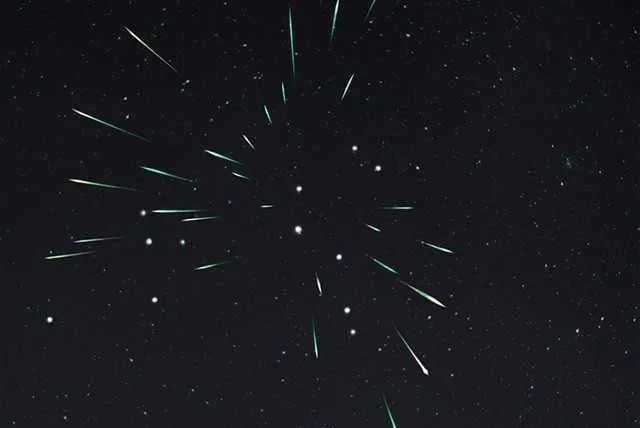
If you observe a phenomenon known as a “shower of stars”, it might seem like the burst originates from a solitary location. This is called meteor shower radiation. It occurs because the luminous dust particles have nearly identical origins and are in close proximity to each other.
Around 300 mineral compounds have been discovered in these luminescent objects that plummet to the Earth and can be examined. Their primary components consist of iron, silicon, and nickel. Occasionally, these objects contain significant amounts of iron sulfide, such as troilite.
Common inorganic compounds found in natural rock formations include olivine and various compositions of pyroxene. These substances are present in silicates as small crystals or mixtures in varying proportions.
As a result, natural stones can be classified into three types: stones composed of different minerals, iron stones made up of nickel-iron alloys, and iron meteorites containing iron and silicates.
Meteorite rocks often originate from fragments of asteroids or meteors, which is why meteor showers can be observed every year in early summer.
The Leonids: A November Meteor Shower
In November, there have been instances of radiation showers in both 1799 and 1833. American astronomer Newton, using data from an old Belgian teapot, determined that the recurrence of this meteor shower happens every 33.25 years. With remarkable accuracy, he predicted the arrival of the heavy Leonid rains in 1866.
On November 13, 1866, an astonishing phenomenon occurred for an entire hour: approximately 20,000 meteors streaked across the sky, originating from a single point in the constellation Leo and scattering in all directions.
Upon calculating the trajectory of the particles responsible for the Leonid shower, British astronomer Adams discovered that it perfectly matched the orbit of a comet spotted by Italian astronomer Templer in late 1865. This same comet had also been observed by Schubert upon his return to Perillo in April 1965, aligning with mentions of the comet in ancient records from 1366 and 1699.
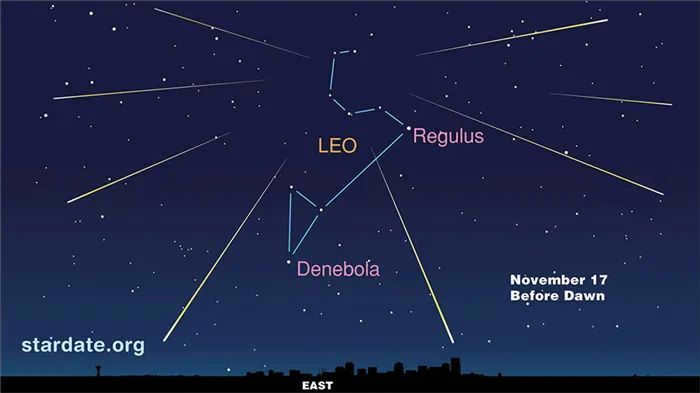
The Leonids meteor stream has a unique radiation pattern. Interestingly, despite its name, the meteor shower is not associated with the constellation Leo. However, this connection between the name and the actual source of the meteors is purely coincidental!
Halley’s Comet: Aquarids and Orionids Meteor Showers
The Aquarids and Orionids meteor showers are direct results of the famous Halley’s Comet. These meteor showers occur when the Earth crosses the path of the comet’s orbit and intersects with the meteor stream.
In the last decade of May, the Aquarids meteor shower radiates in the constellation of Aquarius, while in the last decade of October, the Orionids meteor shower radiates in the constellation of Orion.
As the Earth passes through the descending orbit of Halley’s Comet in May and through its ascending node in October, two distinct meteor streams are formed. The May stream is expected to emit meteors towards the south, while the October stream emits meteors towards the north of the ecliptic plane.
Andromedida meteor stream
In 1826, the Austrian comet Biela had a rotation period of 13 years: it was observed in 1772 and 1805, when it was identified and reappeared, as expected, in 1832. However, the comet did not make its anticipated reappearance in 1839, and on November 26, 1845, Comet Viera suddenly “reappeared” as discovered by astronomer de Vico in Rome.
Early the following year, on January 13, the comet was observed to divide into two separate comets, which continued to move closer in the sky. By the end of March, the dimmer comet had faded away, and the brighter one followed suit at the end of April.
In 1872, both Becher’s comets were not detected in their intended paths, but on November 27 of that same year, a strong radial “meteor shower” was witnessed in the Andromeda constellation. Evidently, Becher’s comet, which had split into two, continued to orbit as a “meteorite” fragment, gradually disintegrating until its core eventually broke apart.
Periodically, when the Earth neared its previous orbit, “meteor showers” were observed in 1798, 1803, and 1838. It seems that Becher’s comet perished, but the meteorite rain persisted in the Andromeda constellation. The Andromeda meteor shower was last seen in 2015.
To be honest, many people often confuse meteors and meteorites. Therefore, it is necessary to understand what they are and what similarities and differences they possess.
Let’s start by defining some terms.
A meteor is a phenomenon that occurs when meteoric bodies collide with and burn up in the Earth’s atmosphere.
A meteorite is a solid cosmic object that lands on the surface of the Earth or another large celestial body.
This raises the question: what exactly is a meteoric body? In other words, it is a meteoroid. This term refers to celestial bodies that are larger than space dust but smaller than an asteroid. They travel through space at incredibly high speeds. When they enter the Earth’s atmosphere, they heat up due to friction, disintegrate, and burn up. This creates a luminous phenomenon known as a meteor.
What distinguishes a meteor from a meteorite?
In actuality, meteoroids, meteors, bolides, and meteorites can all be considered the same entities. These are extraterrestrial objects that exist within the universe. However, they were assigned different names for a reason.
The primary distinction lies in their location, or rather, where they are or where they end up.
Meteoroid. → resides in the space environment.
Meteor → traverses Earth’s atmosphere.
Meteorite → lands on Earth’s surface.
Indeed, the distinctions between a meteor and a meteorite are evident from their definitions. To reiterate, the former refers to a phenomenon, while the latter denotes a celestial body that has made contact with the Earth.
Moreover, their disparities extend to their composition and size, which consequently impact their trajectory and ultimate destiny.
It is also pertinent to mention that the remnants of a meteoroid that successfully land on the Earth’s surface are referred to as meteorites.
Differences and Similarities between Meteors and Meteorites
When it comes to meteor bodies, meteors, and meteorites, they all start off the same size, assuming they are a single object. However, the range of sizes can vary greatly. The smallest size is smaller than a grain of sand, while the largest meteorite ever found on Earth is a massive 2.7×2.7×0.9 meters in size, with a volume of 9 m³ and weighing over 60 tons.
In my perspective, the comparison of meteors and meteorites lies in their fundamental concepts. They both originate from the same source and share a similar nature in terms of appearance. However, they have different destinies and can undergo different transformations under specific conditions. It’s fascinating to think about these celestial rocks, composed mainly of hard rocks and iron, and how they can vary in their final stages.
Today, we have gained knowledge about the various celestial entities, namely meteoroids, meteors, bolides, and meteorites. Without a doubt, each of these cosmic bodies possesses its own unique characteristics that make them fascinating. Not only do they leave a lasting impact in the heavens above, but they also leave an indelible mark on our planet Earth.
Description
An animation showing a brilliant meteor (-3 stars) with a streak originating from the Geminid stream, captured on December 9, 2010 at SAO RAS.
Meteorites and meteoroids should be distinguished from meteors. A meteor refers to the luminous trail left by a meteoroid and is considered a phenomenon rather than an object. Whether the meteoroid returns to outer space, burns up in the atmosphere due to friction, or falls to Earth as a meteorite, it is still referred to as a meteor.
In addition to its mass and size, a meteor can be identified by its velocity, ignition altitude, track length, luminosity, and chemical composition, which determines its color when it burns. So, let’s assume that a meteor enters Earth’s atmosphere with a velocity of 40 km/s and reaches a magnitude of 1. It ignites at an altitude of 100 km and extinguishes at 80 km, leaving a visible path of 60 km. If the observer is 150 km away, the flight duration would be approximately 1.5 seconds. Based on these measurements, we can estimate that the average size of the meteor is 0.6 mm and its mass is 6 mg. [1]
Meteor streams, which are permanent masses of meteors that appear at specific times of the year and on specific sides of the sky, are often observed. Some well-known meteor streams include the Leonids, Quadrantids, and Perseids. These streams are formed when comets pass through the solar system and are destroyed, resulting in the creation of meteor streams.
When observing meteor streams visually, it is common to see meteors emanating from a single point in the sky known as the radiant. This is because the cosmic dust that gives rise to meteor streams originates from a similar source and is relatively close to each other in outer space.
In addition to visual and photographic techniques for examining meteors, the past 50 years have witnessed the advancement of electron-optical, spectrometric, and radar methods that rely on the ability of meteor trails to scatter radio waves. By utilizing radio meteor sounding and studying the movement of meteor trails, valuable information about the condition and dynamics of the atmosphere at altitudes of approximately 100 km can be obtained. Additionally, meteor radio communication channels can be created. Key installations for meteor research include photographic meteor patrols and meteor radar stations. Among the prominent international meteor research programs, the GLOBMET program from the 1980s is particularly notable [3].
However, it should be noted that our system is replete with various celestial objects that are much smaller than planets, with meteorites being one example.
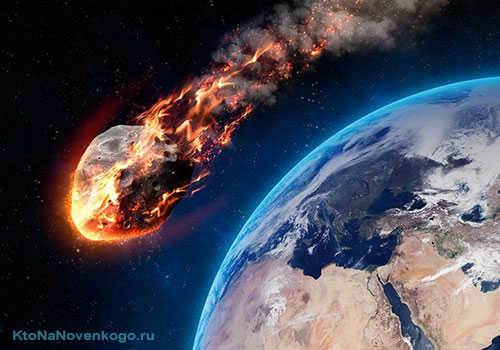
What is the definition of a meteorite? How does it differ from a meteor? Which meteorites hold the record for being the largest? These are the questions we will be addressing today.
A meteorite is a small celestial object
A meteorite is a small celestial object that can descend to the surface of Earth due to the intersection of its orbit with that of our planet.
Meteorites can fall not only on our planet, but also on all other major bodies within the solar system. As an example, the moon is covered in craters from the impact of these celestial objects.


When a meteorite enters the Earth’s atmosphere, it enters at an incredibly high speed – ranging from 11 km/s to 72 km/s. This tremendous speed causes the body to heat up and undergo a process of glowing. As the meteorite travels through the Earth’s atmosphere, it may either completely burn up or significantly decrease in size and mass.
If the meteorite does not burn up entirely during its descent, it will release an enormous amount of energy upon impact with the Earth. This will result in a powerful explosion and the formation of a crater as a result.
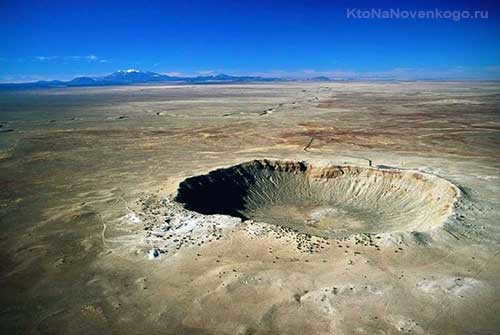
The size of the impact pit can resemble the dimensions of the descending object or it can be significantly larger. This is determined by the velocity of the descending object:
- If the velocity is only a few hundred meters per second, the impact pit will be approximately the same size as the meteorite.
- If the object collides with the Earth’s surface at a velocity of several kilometers per second, the size of the impact pit will be much greater than the diameter of the fallen object.
What is the reason for the descent of meteors and meteorites?
What leads to the fall of a meteorite? It is well known that our solar system contains numerous small objects, each following its own path in orbit.
However, when any of these objects comes close to the Earth’s atmosphere, it is influenced by the gravitational force exerted by our planet. This close proximity to Earth alters the path of the celestial body significantly.
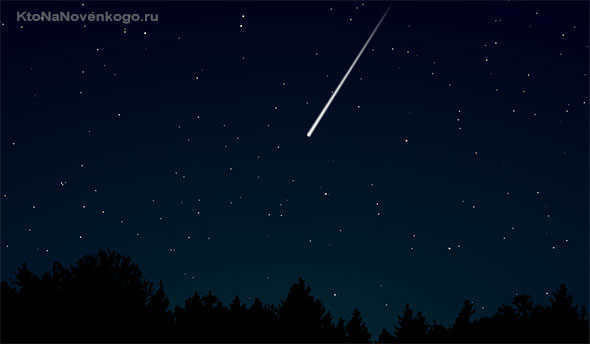
There are meteorites and meteors that move in a clockwise direction around the Sun, while others move in a counterclockwise direction. In light of this, these bodies, in relation to their movement in relation to the Earth, are classified into the following categories:
- Encounters. These bodies can enter the Earth’s atmosphere at a maximum speed of 72 km/s, which is the sum of the Earth’s speed (30 km/s) and the maximum speed of the meteorite, which is 42 km/s.
- Catching up. The speed at which these bodies fall is much lower, around 11 km/s. The speed of meteors also varies depending on the angle at which they enter the atmosphere.
Most of these bodies fall at a speed of 20-25 km/s.
What are the components of a meteorite?
Meteorites can be categorized into several different types:
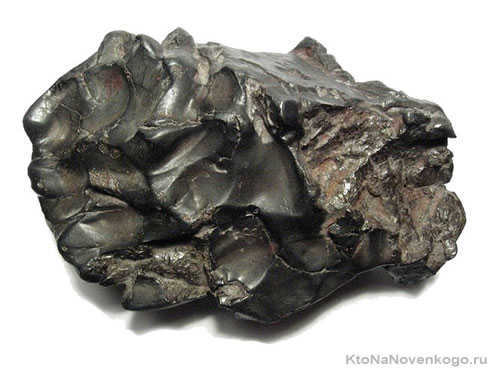
- Iron meteorites, which were previously part of the core of dead planets or asteroids, are primarily composed of iron (about 90-95%), with the remaining mass consisting of nickel and other elements. They make up approximately 5-6% of all meteorites that fall to Earth.
- Stone meteorites, on the other hand, originate from the outer shell of a planet or asteroid. They closely resemble ordinary stones, especially when they are of a similar size, making them difficult to distinguish for some individuals.
- Iron-stone meteorites are formed at the boundary between the crust and mantle of the celestial body they were previously a part of. These meteorites comprise only 2% of all known meteorites.
Within the category of stone meteorites, there are further subdivisions:
- Chondrites compose the majority of celestial bodies that have descended to the Earth’s surface.
- Achondrites are another type of meteorite.
Meteorite showers
As previously mentioned, when a meteor enters the Earth’s atmosphere at high velocity, it undergoes significant heating and may completely disintegrate before reaching the Earth’s surface.
During this disintegration, it can fragment into numerous smaller meteorites and meteors, resulting in what is commonly known as a meteor shower.
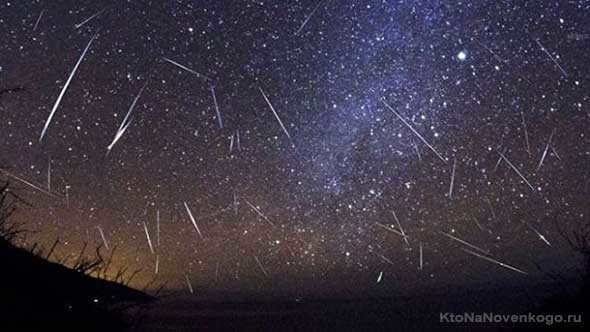
When a massive meteorite descends, it typically leaves a crater on the Earth’s surface. However, when a meteor shower occurs, it creates a field of craters.
The Tunguska Incident
An extraordinary event took place in Siberia on June 30, 1908. A large fireball was observed flying through the sky. A tremendous explosion happened above the uninhabited region of the taiga, at an elevation of 7-10 km. The resulting shockwave was incredibly powerful.
Windows in people’s homes were shattered several hundred kilometers away from the blast site. Over 2,000 kilometers of forest were flattened. If the explosion had occurred in a densely populated area, the consequences would have been catastrophic.

The occurrence became famous as the Tunguska meteorite. Nevertheless, as time went on, scientists started to question whether the term – meteorite – was appropriately given.
There are numerous reasons why this object should not be labeled as such:
- In the center of the explosion, trees remained upright, while in a wide area they were knocked down. In the event of a meteorite impact, a crater is left at the point of contact with the Earth. However, no crater was discovered.
- Furthermore, the constituents of the celestial body were not found.
Scientists now propose that the object was of cometary origin. Comets’ nuclei are made up of ice crystals and are easily destroyed, which is why this theory has gained supporters. However, there are alternative hypotheses about what the Tunguska phenomenon might have been.
Chelyabinsk meteorite
On the 15th of February, 2013, an explosion occurred in the Chelyabinsk region caused by a meteorite at a height of 15-25 km. This occurrence was accompanied by an enormous blast wave. Numerous pieces of the extraterrestrial object were discovered on the Earth’s surface, with a combined weight of 654 kg.
However, the celestial entity itself had a weight exceeding 1 ton. It was given the name of the Chelyabinsk meteorite.
The largest meteorites in history
While most meteorites have a relatively small mass, with some weighing 100 kilograms or more, there are a select few that stand out for their enormous size. Here is a compilation of the largest meteorites ever discovered:
- The Sikhote-Alin meteorite, which fell in Russia in 1947, boasts a staggering total mass of 23 tons.
- The Girin meteorite, which crashed in China in 1976, weighs an impressive four tons.
- The Allende meteorite, which landed in Mexico, had a weight of 2 tons.
- Kunya Urgench, which fell in Turkmenistan in 1998, had a weight of 1.1 tons.
- The Norton County meteorite, found in the United States in 1948.
- The Chelyabinsk meteorite, which fell in 2013 and weighed a solid 1 ton.
This article explores the fascinating topic of the largest meteorites in history.
Comments and Feedback (2)
Thankfully, the Chelyabinsk meteorite, before it plummeted, essentially disintegrated in the atmosphere, but despite its relatively small size, it managed to inflict significant harm on both structures and human well-being, with many citizens sustaining cuts from shattered window panes.
It is important to bear in mind that sizable meteorites have the potential to not only obliterate a city, but also alter the course of evolution. Just consider the dinosaurs, who dominated the planet for millions of years – according to one prevailing theory, their demise was triggered by the impact of a massive celestial body.
Today, humans reign over the world and, unlike dinosaurs, possess the ability to assess such threats. Unfortunately, at this point, we can only evaluate them and not prevent them.
Incidentally, shooting stars are often colloquially referred to as burning meteors. Interestingly enough, the majority of individuals mistakenly believe that these celestial phenomena are actual falling stars))) Furthermore, humanity as a whole tends to excessively focus on its petty issues, failing to comprehend the potential danger posed by a meteorite collision. One need only observe the moon or Mars to witness the countless craters present, thereby making the magnitude of this threat evident.

